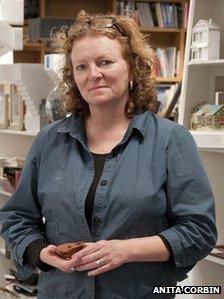Rachel Whiteread unveils golden frieze at Whitechapel Gallery
- Published

Close-up of the facade at Whitechapel Gallery
Sculptor Rachel Whiteread has unveiled her first permanent public commission in the UK - a frieze of golden leaves high above a street in east London.
The Tree of Life sculpture fills a blank space above the entrance to the Whitechapel Gallery.
Whiteread said: "I've made it as a gift to the area, something that will brighten up someone's day."
The artist, the first woman to win the Turner Prize in 1993, has lived near the art gallery for 25 years.
The artwork is one of the major commissions of the <link> <caption>London 2012 Festival</caption> <altText>London 2012 Festival</altText> <url href="http://www.bbc.co.uk/2012/festival" platform="highweb"/> </link> , the culmination of the Cultural Olympiad.
"It's wonderful to have something in the high street that isn't a franchise or a brand," said filmmaker Danny Boyle, the artistic director of Olympic Games opening ceremony.
Speaking at Thursday's launch event, the Trainspotting director added that the sculpture was "a breath of air that picks up something that's not litter in our high street".
Whiteread's work was inspired by the Whitechapel Gallery's existing architecture which features a Tree of Life motif on its terra-cotta panels.
Cast in bronze and covered in gold leaf, the artwork's leaves and branches create a flurry across the front of the building visible to anyone passing in the street.

Rachel Whiteread was the first woman to win the Turner Prize in 1993
Gallery director Iwona Blazwick said Whiteread's frieze had joined London's repertoire of high-level gilded sculptures.
"There are angels and weather vanes and the most extraordinary features decorating our rooftops," she said. "I think we should have a campaign to get people to look up a bit more and see these hidden treasures."
The Whitechapel Gallery building, opened in 1901, was "finally complete", she said.
Original plans for a frieze in the recessed space above the entrance were never realised, leaving it empty for more than 100 years.
Rachel Whiteread's sculpture often takes existing architectural structures as its starting point.
She came to public attention in 1993 with House, a life-sized cast of the interior of a Victorian terraced property in east London. Her sculpture Monument was commissioned for the Fourth Plinth in Trafalgar Square in 2001.
Whiteread's Holocaust Memorial (2000) in Vienna and Water Tower (1998) in New York remain as permanent public sculptures.
"I don't think there's anything profound about the work," Whiteread told the BBC at Thursday's unveiling.

Whitechapel Gallery facade (seen left), with the Tree of Life by Rachel Whiteread
"It's connected with the architecture, the sociology and anthropology of the area. I've worked with the local foundry, so it's all very much East End-based."
She spoke of having a "eureka moment" during a walk in Italy. "I plucked a twig off a tree and said this the kind of thing I want to do!"
Whiteread, who doesn't like to work on a computer, designed Tree of Life after building a full-scale model of the facade of the Whitechapel Gallery in her studio.
Much of the external construction work took place amid the recent extreme weather conditions.
"The first time I went up to see the Tree of Life was in a blizzard with a force 10 gale," recalled Whiteread. "In the past two months we've been installing during the monsoon period."
Whiteread's commission was mainly financed by the Art Fund, with support from the Henry Moore Foundation.
Ruth Mackenzie, director of the London 2012 Festival, said the "ravishingly beautiful" sculpture was free to be admired by the millions who travel down Whitechapel High Street.
"We've got a golden legacy that shouts from the rooftops, literally," she said.
Sculptor Antony Gormley told the BBC: "Rachel's genius is that she allows the past to become present in a way that nobody else can.
"These wonderful golden things hover on the facade and give it a kind of vitality. It's both extremely reserved but incredibly joyful."
- Published9 February 2012